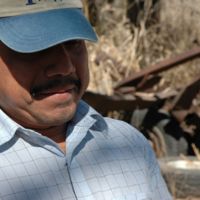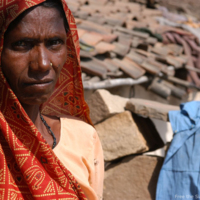
After this I went off with my cousin looking for work further north, up near the forest. This is where the gato caught me. The gato is like an actor, he comes along and is very nice, he understands how much you need a job, and he says he can help. He’ll recruit several young men at a time in town, but when you get to the countryside, up on the edge of the forest, the gato becomes a villain.
When he recruited me, he said I would be paid 12 reais (about $7) for every ‘line’ of trees I cut. A ‘line’ was about 50 square meters, and was about all you could cut if you worked hard from 4 am until sundown. This is the raw forest, and the vegetation is very thick, some of the trees are enormous, but there are others of every size, along with thorn bushes, vines, snakes, and lots and lots of insects. To do the work we had to buy equipment from the gato, boots, knives, hooks, machetes, and axes, and they were really expensive.
When we started to work there, we realized this was a bad situation. For breakfast the gato only gave us a little coffee and some manioc flour, at lunchtime there would be a small amount of rice, maybe some beans if we were lucky. Working this hard we were really hungry, and after a couple of days we just said, ‘Forget it! We want to leave’. But the gato said, ‘No!
You owe me money, a big debt for the tools and the food and the cost of bringing you out here’. And then he showed us his gun. So we thought, ‘OK, we’ll work out this debt and go’, but the debt just kept getting bigger and bigger. And the situation just got worse, our only shelter was a little bit of plastic over sticks, rats were running over us in our sleep, our only water was from a dirty pond, and our only toilet was the forest.
One of the worst things was what the gato was doing to two young guys who were thirteen or fourteen. At night he would come to the shelter and take one of them away at gunpoint. Off in the middle of the forest, he’d put his gun to the boy’s head, and rape him, forcing him to do things. Sometimes he’d hit him with his pistol as well. It was terrible, we wanted to help them, but we were afraid that he’d shoot us. These boys were in bad shape.
After five months I had just had enough, and I told my cousin I was going to run for it. He was frightened and told me that I would be killed. By this time the gato had two other men watching over us with guns. But I was determined and willing to take the risk.
As told in an interview with Kevin Bailes published in The Legal Understanding of Slavery: From the Historical to the Contemporary









